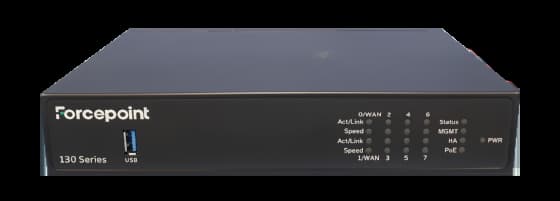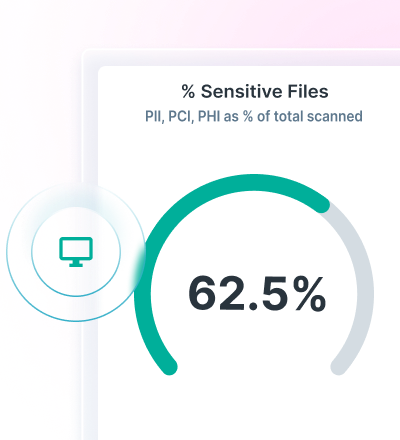
Más de 12.000 clientes no podían equivocarse










































Escale y proteja el acceso a la red para oficinas, sucursales y ubicaciones remotas.
Redes de área amplia —conozca la seguridad. Forcepoint Secure SD-WAN protege la red de amenazas avanzadas con controles de seguridad Zero Trust mientras mantiene una conectividad superior en cualquier parte del mundo.
¿Por qué Forcepoint Secure SD-WAN?
Centralice la administración: Active sucursales, oficinas y ubicaciones remotas desde la nube. Configure políticas una vez y utilice la implementación sin intervención con la Secure Management Console (SMC).
Mejore el rendimiento de las aplicaciones: Reduzca la latencia y la fluctuación, y asegúrese de que las aplicaciones críticas reciban prioridad de ancho de banda a través de la conectividad Multi-Link, el manejo dinámico del tráfico, el monitoreo del estado de las aplicaciones y otras funciones.
Protéjase contra amenazas avanzadas: Detecte y evite el riesgo mediante la inspección de multicapa, la prevención de intrusiones, la retención de DNS y más, al mismo tiempo que protege el acceso a las aplicaciones en las instalaciones o de forma remota a través del conector de aplicaciones de ZTNA.
Reduzca los costos operativos: Reduzca los costos de redes y mejore la confiabilidad con la combinación y el emparejamiento en tiempo real de la banda ancha de ISP local y la selección de MPLS privada.
Datasheet
Compare los modelos de dispositivos


Global Network
20+
Countries
45+
Cluster Nodes
Clustering In a Way No One Else Can Do
Christian Keller, CISO at Huber + Suhner, lists reliability, clustering, and ability to navigate global compliance requirements among the top benefits of Forcepoint NGFW.
Explore los modelos de Forcepoint Secure SD-WAN

Serie 3500
Es ideal para grandes empresas, redes de campus y data centers.
Hasta 66 interfaces
Rendimiento del firewall de hasta 600 Gbps
Rendimiento del NGFW del sistema de prevención de intrusiones de hasta 140 Gbps

Serie 3400
Es ideal para redes de campus y data centers.
Hasta 67 interfaces
Rendimiento del firewall de hasta 200-300 Gbps
IPS NGFW de hasta 15-35 Gbps

Serie 2200
Es ideal para oficinas medianas y grandes.
Hasta 25 interfaces
Rendimiento del firewall de hasta 120 Gbps
Rendimiento del NGFW del sistema de prevención de intrusiones de hasta 13.5 Gbps

Serie 1200
Es ideal para oficinas medianas y grandes.
Hasta 17 interfaces
Rendimiento del firewall de hasta 65 Gbps
Rendimiento del NGFW del sistema de prevención de intrusiones de hasta 5 Gbps

Serie 350
Es ideal para sitios remotos y sucursales (diseño de escritorio).
Hasta 13 interfaces
Rendimiento del firewall de 40 Gbps
Rendimiento del NGFW del sistema de prevención de amenazas de 2 Gbps (N352) o 4.1 Gbps (N355)

Serie 130
Ideal for remote offices, branches and stores.
Hasta 8 interfaces
Rendimiento de firewall 8 Gbps
IPS NGFW 1,600 Mbps

Serie 120
Es ideal para ubicaciones físicas y sucursales.
Hasta 8 interfaces
Rendimiento del firewall de 4 Gbps
NGFW del sistema de prevención de intrusiones de 450 Mbps

Serie 60
Es ideal para oficinas remotas, sucursales y ubicaciones físicas.
Hasta 4 interfaces
Rendimiento del firewall de 2 Gbps
Rendimiento del NGFW del sistema de prevención de intrusiones de 350 Mbps
Imágenes de la nube:
- Software unificado Forcepoint NGFW
- Soporte para Amazon Web Services (AWS)
- Soluciones de Microsoft Azure
- Protege la comunicación norte-sur dentro y fuera de la nube y el tráfico SDN este-oeste
Dispositivos virtuales:
- Software unificado Forcepoint NGFW
- Disponible para KVM y VMware ESXi y NSX
- Escala a 64 CPU
- Automatiza la microsegmentación de red
- Puede agruparse con firewalls físicos


La guía del comprador para Secure SD-WAN
Ya sea un comprador por primera vez o que esté considerando una actualización, nuestra guía tiene los criterios clave para evaluar las soluciones de Secure SD-WAN. Descubra las cinco consideraciones clave que debe tener en cuenta.
Por qué los clientes eligen SD-WAN
Por qué los clientes eligen SD-WAN
"Our costs - both for the project and maintenance - are going down because we don't need resources locally, we have centralized everything. If we want new service on a train, we define the policy then give the hardware to the operator, who installs it."
VR Group
Frequently Asked Questions
What is managed SD-WAN?
A managed SD-WAN is a service where a provider handles the deployment, configuration, monitoring and optimisation of your WAN. Meanwhile, a cloud-managed SD-WAN adds centralised control via the cloud, making it easier to apply consistent policies, improve performance and maintain security across distributed networks without internal resource strain. Learn more about this product through our comprehensive managed SD-WAN solutions guide.
What are the benefits of SD-WAN?
Benefits of Forcepoint Secure SD-WAN include the following:
Centralized management
Improved application performance
Protection against advanced threats
Reduced operating costs
How much does SD-WAN cost?
SD-WAN costs are determined by factors, including the type of deployment, the size of the network, the number of locations to connect, the type and amount of data transiting the network and any existing infrastructure that may be leveraged when deploying an SD-WAN solution.
What is SD-WAN security?
SD-WAN security helps organizations enable effortless connection to cloud resources while protecting users, data and IT environments from attack.
What is an SD-WAN solution?
Ad SD-WAN solution applies software-defined networking principles to the wide area network.
What is an SD-WAN provider?
SD-WAN providers enable organizations to deploy SD-WAN technology.
What is an SD-WAN appliance?
SD-WAN appliances are physical or virtual controllers located on-premises or in the cloud that connect an organization’s users to applications, services and workloads.
How do SD-WAN appliances work?
SD-WAN appliances and products are designed to overcome the challenges of ensuring fast and secure connectivity for branch locations and hybrid workforces. The traditional wide area network uses a hub-and-spoke model that requires all traffic to flow through a central data center. For organizations with a highly distributed workforce, this model adds unacceptable levels of latency that negatively affect user experiences and productivity. Additionally, legacy WANs are built with costly Multiprotocol Label Switching (MPLS) connections that are time-consuming to manage and deploy, preventing organizations from scaling easily and cost-efficiently. SD-WAN overcomes these issues by creating a virtual overlay for the network that abstracts network connections and enables the use of additional, low-cost transport services that add redundancy and flexibility.
What is Multiprotocol Label Switching (MPLS)?
Multiprotocol Label Switching (MPLS) is data forwarding technology that increases the speed and controls the flow of network traffic.
What is SD-WAN vs MPLS?
SD-WAN is a networking technology that uses software to make wide area networks more intelligent and flexible by connecting sites directly to the internet over commodity broadband links. Configurations and access policies are centrally managed and easily applied across all sites, removing the need to manual administer each WAN device individually. MPLS is data forwarding technology for network traffic that directs data through a path via labels instead of requiring complex lookups in a routing table at every stop. Traditional networking technology, MPLS, has seen competition from SD-WAN solutions to meet today's high demands and expanding needs for networked business-critical systems.










